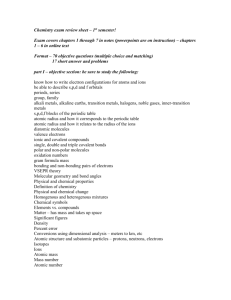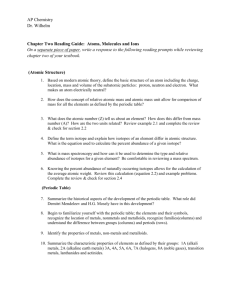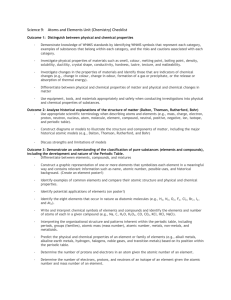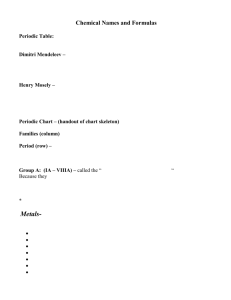Atoms Student Outline
advertisement
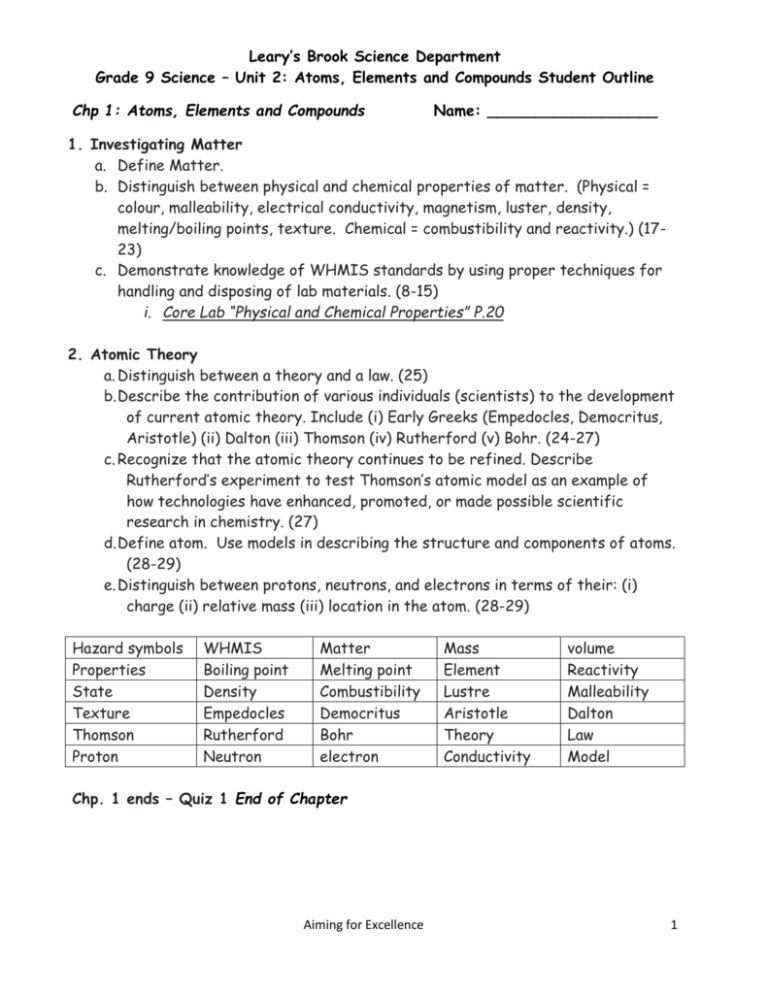
Leary’s Brook Science Department Grade 9 Science – Unit 2: Atoms, Elements and Compounds Student Outline Chp 1: Atoms, Elements and Compounds Name: __________________ 1. Investigating Matter a. Define Matter. b. Distinguish between physical and chemical properties of matter. (Physical = colour, malleability, electrical conductivity, magnetism, luster, density, melting/boiling points, texture. Chemical = combustibility and reactivity.) (1723) c. Demonstrate knowledge of WHMIS standards by using proper techniques for handling and disposing of lab materials. (8-15) i. Core Lab “Physical and Chemical Properties” P.20 2. Atomic Theory a. Distinguish between a theory and a law. (25) b. Describe the contribution of various individuals (scientists) to the development of current atomic theory. Include (i) Early Greeks (Empedocles, Democritus, Aristotle) (ii) Dalton (iii) Thomson (iv) Rutherford (v) Bohr. (24-27) c. Recognize that the atomic theory continues to be refined. Describe Rutherford’s experiment to test Thomson’s atomic model as an example of how technologies have enhanced, promoted, or made possible scientific research in chemistry. (27) d. Define atom. Use models in describing the structure and components of atoms. (28-29) e. Distinguish between protons, neutrons, and electrons in terms of their: (i) charge (ii) relative mass (iii) location in the atom. (28-29) Hazard symbols Properties State Texture Thomson Proton WHMIS Boiling point Density Empedocles Rutherford Neutron Matter Melting point Combustibility Democritus Bohr electron Mass Element Lustre Aristotle Theory Conductivity volume Reactivity Malleability Dalton Law Model Chp. 1 ends – Quiz 1 End of Chapter Aiming for Excellence 1 Leary’s Brook Science Department Grade 9 Science – Unit 2: Atoms, Elements and Compounds Student Outline Chp 2: Elements are the Building Blocks of Matter Name: ___________________ 3. Elements a. Define element and recognize that elements are represented by an internationally agreed upon system of symbols (38-39) b. Identify and write chemical symbols for common elements. Identify each element symbol as either an uppercase symbol or an uppercase letter followed by lower case letter. (40-46) hydrogen iron nitrogen silicon sodium nickel oxygen silver potassium copper neon gold magnesium zinc helium mercury calcium carbon chlorine lead 4. Elements and the Periodic Table a. Identify the Periodic Table as a listing of all known elements and describe Mendeleev’s contribution to its development. (48) b. Distinguish between atomic number and atomic mass. Using atomic mass and atomic number for an element, determine its number of protons, electrons, and neutrons. (49) 5. Organization of the Periodic Table a. Using the Periodic Table, develop an understanding that the elements are grouped on the basis of similar characteristics. (51-57) Metals Non-metals Metalloids Alkali metals Alkaline Earth Metals Halogens Noble Gases Transition Metals b. List properties of metals and non-metals. (i) Lustre (ii) malleability (iii) conduct electricity (iv) conduct heat. (51) c. Define period and family. (52) d. Provide examples of common properties which a family of elements shares. (i) noble gases (ii) alkali metals (iii) halogens and (iv) alkaline earths. (52-53) 6. The Periodic Table and Atomic Theory a. Define energy level, valence energy level and valence electron. (60) b. Draw Bohr-Rutherford models of elements 1 to 18 and identify the maximum number of electrons which exist in the first three energy levels. (60-62) c. Make comparisons of energy level diagrams for elements from the same family. Key Terms: chemical symbol alkaline earth metals noble gases valence electrons metal atomic mass period Metalloids non-metal atomic number Bohr-Rutherford diagram Transition Metals periodic table chemical family electron shells alkali metals halogens energy levels Chp 2 ends – Quiz 2 Mid Jan Aiming for Excellence 2 Leary’s Brook Science Department Grade 9 Science – Unit 2: Atoms, Elements and Compounds Student Outline Chp 3: Elements Combine to form Compounds Name: ______________________ 7. Chemical Compounds a. Define compound and identify whether a compound is ionic or molecular. (72-74) b. Identify that a compound is represented by a combination of element symbols known as a chemical formula, which indicates the proportion in which the elements are present. (80-82) i. List chemical formulas for some common ionic compounds. Include: (i) table salt or sodium chloride (NaCl) (ii) calcium carbonate (CaCO3) (iii) sodium sulfite (Na2SO4) (iv) sodium hydroxide (NaOH). (82) ii. Name simple ionic compounds using IUPAC rules. iii. List chemical formulas for some common molecular (covalent) compounds. Include: (i) sucrose or table sugar (C12H22O11) (ii) carbon dioxide (CO2) (iii) methane (CH4) (iv) water (H2O). (83) iv. Name simple molecular compounds using IUPAC rules. 8. Evidence of Change in Matter a. Distinguish between physical and chemical changes. (86-87) b. Recognize that chemical changes produce new substances (elements or compounds), but physical changes do not. (87) c. List examples of physical and chemical changes. (88-89) Include: Physical: (i) change of state ii) cutting iii) dissolving. Chemical: (i) corrosion (ii) fruit ripening (iii) combustion. d. List evidence that a chemical change may have occurred. (89) (i) Heat/Light is produced or absorbed (ii) New color appears (iii) Precipitate forms (iv) Gas is produced (v) Process is difficult to reverse e. Recognize that during a chemical change, elements are conserved but compounds are not. Core Lab “Observing Changes in Matter” (92-93) 9. Chemistry in Everyday Life a. Provide examples where knowledge of chemistry has resulted in the development of commercial materials. b. Explain how a need in society can lead to developments in chemistry. c. Analyze the design of a technology and the way it functions on the basis of its impact on their daily lives. d. Make informed decisions about applications of science and technology, taking into account environmental and social advantages and disadvantages. i. Core STSE “Plastics and Modern Life” Terms to Know: chemical bonds molecule ionic compound molecular compound chemical formula chemical name chemical change combustion condensation corrosion evaporation physical change dissolving products melting freezing reactants IUPAC Precipitate Unit Test – Aiming for Excellence 3
